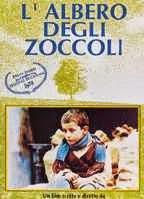 Ermanno Olmi’s The Tree of Wooden Clogs, a 3-hour long feature film, won the prestigious Golden Palm and the prize of the Ecumenical Jury at the Cannes Film Festival in 1978. For those who have been fortunate to have sat through the slow-paced realistic film right up to its end, it would prove to be a rare cinematic entertainment, indelible from their memories. It would touch any sensitive individual’s heart and mind in a way few movies can. It is a film without a single professional actor and yet when the respected Hollywood thespian Al Pacino was asked to identify his favorite film, the first name that came to his mind was The Tree of Wooden Clogs. That statement says a lot about the quality and credibility of the performances by the ensemble of non-professional actors gathered by Olmi from his own village in Bergamo, Lombardy, Italy.
Ermanno Olmi’s The Tree of Wooden Clogs, a 3-hour long feature film, won the prestigious Golden Palm and the prize of the Ecumenical Jury at the Cannes Film Festival in 1978. For those who have been fortunate to have sat through the slow-paced realistic film right up to its end, it would prove to be a rare cinematic entertainment, indelible from their memories. It would touch any sensitive individual’s heart and mind in a way few movies can. It is a film without a single professional actor and yet when the respected Hollywood thespian Al Pacino was asked to identify his favorite film, the first name that came to his mind was The Tree of Wooden Clogs. That statement says a lot about the quality and credibility of the performances by the ensemble of non-professional actors gathered by Olmi from his own village in Bergamo, Lombardy, Italy.Why is The Tree of Wooden Clogs an outstanding film? Few films are made by directors that are based on a script totally written and developed by themselves, without the aid of professional screenplay writers. Ingmar Bergman and Terrence Malick are prominent examples who can be termed original screenplay writers. But their films are always photographed by regular cinematographers. Few are the films where the director is the sole cameraman as well. The Tree of Wooden Clogs is one such rare example. And finally, how many filmmakers edit their own cinematic works without help from professional editors. Ermanno Olmi is one. Thus The Tree of Wooden Clogs is a rare film where so many critical roles of the film-making process—including casting of non-professional actors---can be credited to a single individual.Olmi explained his penchant for picking non-professional actors in an interview given to Bert Cardullo, Professor at the Izmir University of Economics, Turkey: “In a film about peasants, I choose the actors from the peasant world. I don’t use a fig to make a pear. These people, these characters, bring to the film a weight, really a constitution of truth, which, provoked by the situations in which the characters find themselves, creates palpitations—those vibrations so right, so real, so believable, and therefore not repeatable. At the twentieth take, the professional actor still cries. The real actor, the character taken from life, won’t do more than four repetitions.” (Cineaste,Vol.XXXIV, No.2, 2009)Olmi’s The Tree of Wooden Clogs resembles a 3-hour long documentary and yet it is not one. It is realistic fiction. It weaves the stories of four peasant Italian families, who serve as tenant farmers to a rich landlord in 1898. Olmi is able to find buildings that resemble those of that period so that the viewer feels the authenticity of the tale. The viewer is introduced to a time and place where the peasants wore wooden clogs instead of shoes and these clogs were made from certain trees that lined to the paths to the peasants living quarters. But the trees belonged to the landowners and the peasants had no ownership of those trees. Recalling bits of oral history from his mother, Olmi fashions a film that weaves realistic details that depict their mostly honest hardworking activities that could get further worrisome if the landlord found them to be dishonest.
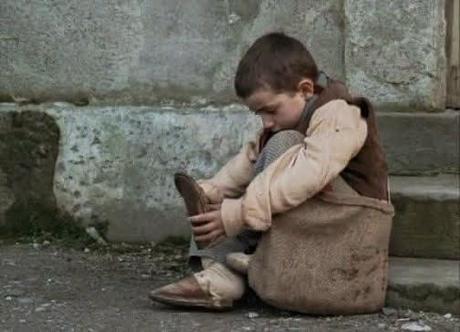
Education and poverty
Being a fervent Roman Catholic, Olmi’s peasant families in The Tree of Wooden Clogs are fleshed out as devout Christians, who listen with respect and reverence to their priests and nuns and say their prayers each day with devotion. Right at the beginning of the film, a priest advises one of the heads of the four peasant families to send his son to school, even if it meant one less person to help him in the fields. It is advice well meant, as most of the peasants are illiterate, and education of one member of the family would indeed pave the way for a better life than providing an extra pair of hands for the head of the family to till the land and harvest the produce. And this advice that the elder peasant accepts becomes the fulcrum of the film’s tale and gets closely associated with the movie’s title. Even science of the day (the veterinarian’s prognosis that a milch cow, an important source of financial sustenance for one of the four poor families in the film, is dying) is superseded by the fervent religious faith of a woman and her prayer miraculously cure's the cow written off by the veterinarian Another religious and economically poor widow skips going to church on Sundays so that she could wash more clothes of the landlord’s family and thus earn more money to feed her children. The flip side of religion is also ambiguously stated—a priest offers to take away two of her children to a monastery, ostensibly to lessen her financial burden. But the eldest son prefers that they stay with them as he has started earning. A nun gifts a one-year old orphan to a newly married couple to bring up as their own as the parents would be rewarded financially—a “gift” the shocked couple cannot refuse. There is further religious ambiguity, if the viewer carefully studies the spoken words of the peasants. Before killing a fattened pig, one peasant comments, “I know how it was raised. I cared for it better than any Christian.”
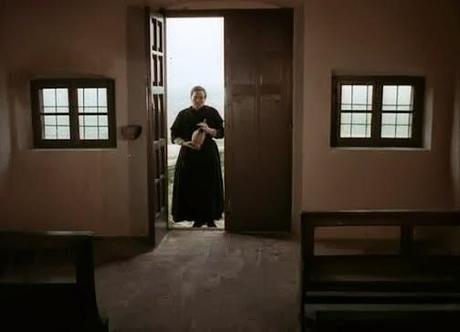
When everything around the poor fails, there is religion
These details form the delightful mosaic of humility and goodwill that pervade the diverse lives of the peasants. A child trudges miles to study in a school, a privilege of richer folks, wearing a pair of clogs that eventually gives way. A pregnant mother opts to give birth without the help of a midwife so that the money saved could be used to buy warm clothes for her elder kids. There is care for each other and discrete sorrow expressed within closed doors at another neighboring family’s misfortune.
Olmi is not just a devout Christian but also a socialist. There is a political uprising against the glaring social divide but the peasants of Olmi’s tale seem oblivious of politics. A newlywed peasant couple pass a stream of chained prisoners being led away by the law-keepers, apparently unable to comprehend the political scenario in the cities. One elder attends a political gathering in a town square but his priorities are to retrieve a gold coin lying on the ground without anyone in the crowd noticing his action rather than listening to the speaker. Olmi seems to underscore one fact—survival from day to day is more important than either politics or religion for the poor, while the rich landlords are content to hear their young ones play Mozart’s “Turkish Rondo” on the piano.
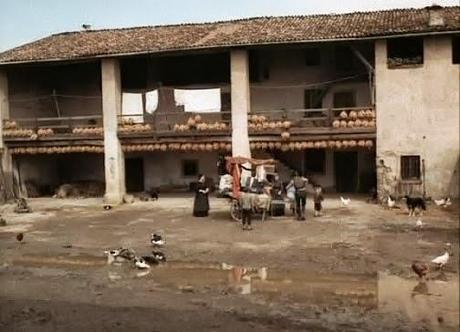
The peasants, the animals and the birds sharing space
What are Olmi’s views on cinema? The Olmi responses to Professor Cardullo’s questions are revealing: “Some would say that the raw material of film is the image, but it’s not just the image. Today we have the image, sound, rhythm. All that is so simple, and at the same time it is complex, just like the unwinding or playing out of life itself. While sound is one moment here, and the image there, cinema is this extraordinary instrument that allows you to reproduce—but “reproduce” isn't the exact word—to repropose some of those moments, some of the fractions of life, to select and compose them into a new mosaic through the editing. This operation consists of choice, image, sound, rhythm, synthesis.”“In the case of my films, they contain a reality that is entirely taken from the real. Within this reality there is the echo of the documentary, but this is documentation that is critically penetrated and put at the service of the content presented.” (Cineaste,Vol.XXXIV, No.2, 2009)
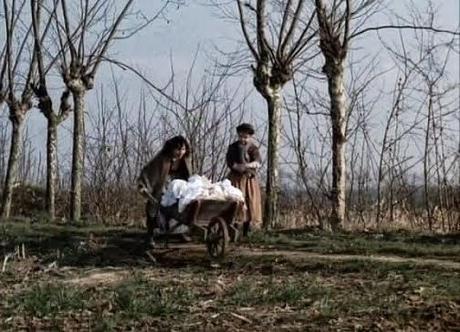
The trees used for making clogs line the path as peasant
children transport washed clothes of the landlord's family
<a href="http://feedjit.com/">Feedjit Live Website Statistics</a>

